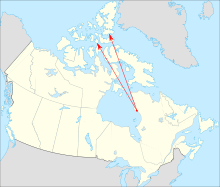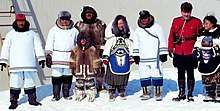History of Nunavut
The region now known as Nunavut has supported a continuous population for approximately 4000 years.

Early history
Beginnings
Mainland Nunavut was first populated approximately 4500 years ago by the Pre-Dorset, a diverse Paleo-Eskimo culture that migrated westward from the Bering Strait region.[1] Evidence suggests the Pre-Dorset culture were seasonally mobile, moving between settlements to take advantage of resources.[2]
_(3034045389).jpg)
The Dorset Culture
The Pre-Dorset culture was succeeded by the Dorset culture about 2800 years ago. Differences between the Pre-Dorset and Dorset cultures include those in lithic technology, art, and styles of building. The Dorset culture additionally lacked the bow and arrow which was utilized by the pre-Dorset.[3]
The Dorset culture has been assumed to have developed from the Pre-Dorset, however the relationship between the two remains unclear.[3]
Helluland, a location Norse explorers describe visiting in the Sagas of Icelanders has been connected to Nunavut's Baffin Island. Claims of contact between the Dorset and Norse, however, remain controversial.[4][5]
The Thule

The Thule people, ancestors of the modern Inuit, began migrating into the Northwest Territories and Nunavut from Alaska in the 11th century. By 1300, the geographic extent of Thule settlement included most of modern Nunavut.
A number of hypotheses have been developed to explain the Thule migration. The historically dominant model posited by Robert McGhee holds that changes in bowhead whale populations brought about by the Medieval Warm Period drew Thule hunters westward. Other hypotheses connect the migration to population pressure, warfare, over-hunting, and Greenlandic iron deposits.[6]
The migration of the Thule people coincides with the decline of the Dorset, who died out between 800 and 1500.[7] While Thule settlers may have adopted Dorset harpoon and hunting technology, there is virtually no evidence confirming contact between the two populations.[1][8]
First written accounts

The written historical accounts of Nunavut begin in 1576, with an account by English explorer, Martin Frobisher. Frobisher, while leading an expedition to find the Northwest Passage, thought he had discovered gold ore around the body of water now known as Frobisher Bay on the coast of Baffin Island.[9] While the ore turned out worthless, Frobisher made the first recorded European contact with the Inuit. Other explorers in search of the elusive Northwest Passage followed in the 17th century, including Henry Hudson, William Baffin and Robert Bylot.
Cold War forced relocations

Cornwallis and Ellesmere Islands feature in the history of the Cold War in the 1950s. Efforts to assert sovereignty in the High Arctic during the Cold War, i.e. the area's strategic geopolitical position, were part of the reason the federal government decided to forcibly relocate Inuit from northern Quebec to Resolute and Grise Fiord. The first group of people were relocated in 1953 from Inukjuak, Quebec (then known as Port Harrison ) and from Pond Inlet, Nunavut. They were promised homes and game to hunt, but the relocated people discovered no buildings and very little familiar wildlife.[10] They also had to endure weeks of 24-hour darkness during the winter, and 24-hour sunlight during the summer, something that does not occur in northern Quebec. They were told that they would be returned home after a year if they wished, but this offer was later withdrawn as it would damage Canada's claims to sovereignty in the area and the Inuit were forced to stay. Eventually, the Inuit learned the local beluga whale migration routes and were able to survive in the area, hunting over a range of 18,000 km² (6,950 mi²) each year.[11]
In 1993, the Canadian government held hearings to investigate the relocation program. The Royal Commission on Aboriginal Peoples issued a report entitled The High Arctic Relocation: A Report on the 1953-55 Relocation.[12] The government paid $10 million CAD to the survivors and their families, but as of 2007 has yet to apologize.[13]
The whole story is told in Melanie McGrath's The Long Exile: A Tale of Inuit Betrayal and Survival in the High Arctic.[14]
Towards autonomy
Leading up to the 1970s, there was some discussion of splitting the Northwest Territories into two separate jurisdictions in order to better reflect the demographic character of the territory. In 1966, a public commission of inquiry on Northwest Territories government reported, recommending against division of the Northwest Territories at the time.

In 1976 as part of the land claims negotiations between the Inuit Tapiriit Kanatami (then called the Inuit Tapirisat of Canada) and the federal government, the division of the Northwest Territories was discussed. On April 14, 1982, a plebiscite on division was held throughout the Northwest Territories with a majority of the residents voting in favour and the federal government gave a conditional agreement seven months later. The land claims agreement was decided in September 1992 and ratified by nearly 85% of the voters in Nunavut in a referendum. On July 9, 1993, the Nunavut Land Claims Agreement Act and the Nunavut Act were passed by the Canadian Parliament, and the transition was completed on April 1, 1999.[15]
External links
- Peter Jull. "Building Nunavut: A Story of Inuit SelfGovernment". The Northern Review #1 (Summer 1988). Yukon College. pp. 59–72. Retrieved 2007-10-27.
References
- "Dorset DNA: Genes Trace the Tale of the Arctic's Long-Gone 'Hobbits'". NBC News. Retrieved 2020-02-20.
- Park, Robert; Milne, S. Brooke. "Pre-Dorset Culture". The Oxford Handbook of the Prehistoric Arctic.
- Houmard, Claire (2018-01-01). "Cultural Continuity from Pre-Dorset to Dorset in the Eastern Canadian Arctic Highlighted by Bone Technology and Typology". Arctic Anthropology. 55 (1): 24–47. doi:10.3368/aa.55.1.24. ISSN 0066-6939.
- Jane George, "Kimmirut site suggests early European contact: Hare fur yarn, wooden tally sticks may mean visitors arrived 1,000 years ago" Archived 2009-08-19 at the Wayback Machine, Nunatsiaq News, 12 September 2008, accessed 5 October 2009
- Weber, Bob (22 July 2018). "Ancient Arctic people may have known how to spin yarn long before Vikings arrived". Old theories being questioned in light of carbon-dated yarn samples. CBC. Retrieved 2 January 2019.
… Michele Hayeur Smith of Brown University in Rhode Island, lead author of a recent paper in the Journal of Archaeological Science. Hayeur Smith and her colleagues were looking at scraps of yarn, perhaps used to hang amulets or decorate clothing, from ancient sites on Baffin Island and the Ungava Peninsula. The idea that you would have to learn to spin something from another culture was a bit ludicrous," she said. "It's a pretty intuitive thing to do.
- Morrison, David (1999). "The Earliest Thule Migration". Canadian Journal of Archaeology / Journal Canadien d'Archéologie. 22 (2): 139–156. ISSN 0705-2006. JSTOR 41103361.
- Friesen, T. Max (2004-12-01). "Contemporaneity of Dorset and Thule Cultures in the North American Arctic: New Radiocarbon Dates from Victoria Island, Nunavut". Current Anthropology. 45 (5): 685–691. doi:10.1086/425635. ISSN 0011-3204.
- Park, Robert W. (1993). "The Dorset-Thule Succession in Arctic North America: Assessing Claims for Culture Contact". American Antiquity. 58 (2): 203–234. doi:10.2307/281966. ISSN 0002-7316. JSTOR 281966.
- "Nunavut: The Story of Canada's Inuit People" Archived 2007-10-03 at the Wayback Machine, Maple Leaf Web
- Grise Fiord: History Archived 2008-12-28 at the Wayback Machine
- McGrath, Melanie. The Long Exile: A Tale of Inuit Betrayal and Survival in the High Arctic. Alfred A. Knopf, 2006 (268 pages) Hardcover: ISBN 0-00-715796-7 Paperback: ISBN 0-00-715797-5
- The High Arctic Relocation: A Report on the 1953-55 Relocation by René Dussault and George Erasmus, produced by the Royal Commission on Aboriginal Peoples, published by Canadian Government Publishing, 1994 (190 pages)"Archived copy". Archived from the original on 2009-10-01. Retrieved 2010-06-20.CS1 maint: archived copy as title (link)
- Royte, Elizabeth (2007-04-08). "Trail of Tears". The New York Times.
- Alfred A. Knopf, 2006 (268 pages) Hardcover: ISBN 0-00-715796-7 Paperback: ISBN 0-00-715797-5
- CBC Digital Archives (2006). "Creation of Nunavut". CBC News. Retrieved 2007-04-26.
Whitcomb, Dr. Ed. A Short History of the Canadian North. Ottawa. From Sea To Sea Enterprises, 2011. ISBN 978-0-9865967-2-8. 62 pp.